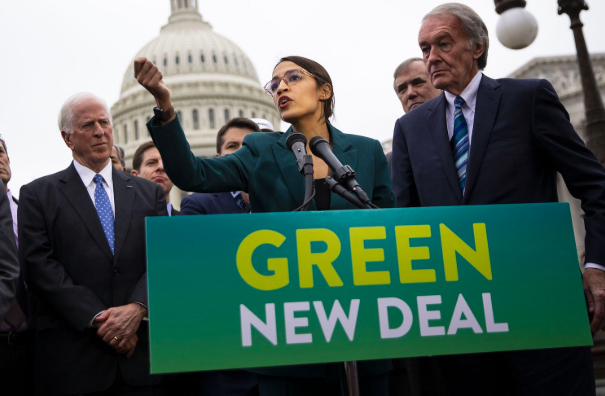
Photo: Al Drago, Bloomberg
By Monica Medina
The hearing this week before the House Reform and Oversight Committee on the national security implications of climate change was an eye-opener. The goal of the hearing was to be non-partisan, with one Republican and one Democrat witness – both former Senators and members of the National Security team. But the Republicans on the Committee blew up the hearing, desperate to change the subject and preferring to use the Green New Deal as their target, rather than the two respected war heroes who came to testify.
Representative Alexandria Ocasio-Cortez did not shrink from the fight – indeed she challenged her Republican colleagues on the Committee to explain how they could misconstrue a fourteen-page resolution that was written in plain English so that any member of the public could know what it proposes. She argued that her critics should read it before labeling it. Indeed, if anything, the Green New Deal is susceptible to this type of mischaracterization because it is a broad and aspirational resolution. It is an environmental Rorschach test.
Centrists are particularly worried by the Green New Deal and the fact that it is being labeled as socialist policy. But in openly agonizing about it, they are falling into the trap laid by the Republicans. To fail to push back on that characterization would be a mistake because the Republicans can’t even agree on whether climate change exists, much less how to deal with it. And as Friend of the Planet and former Republican strategist Kurt Bardella said in yesterday’s Our Daily Planet interview, the Republican Party’s position on climate change “is on the wrong side of history, and in this case the facts and the science, and that is not a tenable position to hold long-term.”
One way to move beyond this debilitating debate is to start to fill in the lines of the Green New Deal. And some Democrats have begun to try to do just that. This week, Representative Scott Peters urged Democrats to adopt a “Climate Playbook” saying that there are dozens of great legislative proposals already working their way through Congress. But his “proposal” is only a list of bills, published on the web site Medium – it does not provide a game plan or even a blueprint for which ones we should do. Others look to market mechanisms like taxing carbon or a carbon fee or want to focus merely on clean energy policy and forget the rest. This is too narrow in my view. We need to make other sectors more sustainable too, such as agriculture, transportation, manufacturing, construction, and we need to increase our capacity to adapt and mitigate climate impacts.
So how do we make the Green New Deal real, without making it incremental and just plain dull? Let’s start with five key building blocks – expanding on current programs with additional funding that have strong potential for bipartisan support.
- Double the funding for Conservation Programs just reauthorized in the overwhelmingly bipartisan 2018 Farm bill. The bill’s two primary working lands conservation programs are the Conservation Stewardship Program (CSP) and the Environmental Quality Incentives Program (EQIP). But there are other “small but mighty” programs such as the Beginning Farmer and Rancher Development Program (BFRDP), Outreach and Assistance to Socially Disadvantaged and Veteran Farmers and Ranchers Program, Farmers Market and Local Food Promotion Program (FMLFPP). Cost = $3.5 billion.
- Instead of cutting the Energy Department’s Applied Energy R&D budget by $2 billion, increase it by $2 billion. Senate Republicans are already starting to get behind a similar proposal – there is currently talk of significantly increasing energy R&D spending. Republican Senator Lamar Alexander of Tennessee is pushing for a “Manhattan Project for Clean Energy” that would double government spending on energy research. And Energy and Natural Resources Committee Chair Republican Senator Lisa Murkowski of Alaska said she is “all in” on Alexander’s proposal. Democrats in the Senate would agree so this too could pass. Cost = $2 billion.
- Increase funding for the Drinking Water State Revolving Fund by $2.5 billion. In 2018, the Drinking Water State Revolving Fund disbursed $2.5 billion for drinking water infrastructure to improve our nation’s public health. This funding could be used specifically to address the widespread problem of PFAS chemicals found in water all over the country, which the Administration pledged to work on last February. Cost = $2.5 billion.
- Double and make permanent the Land and Water Conservation Fund (LWCF) and the Quadruple the 21st Century Conservation Service Corps (21CSC). Congress reauthorized the LWCF last month, but they did not provide funds, much less make them permanent. In addition, Congress could provide 100,000 jobs in conservation to young people and veterans by quadrupling the 21CSC that was reauthorized in March with wide bi-partisan support. Cost = $1 billion.
- Increase the Capacity of the National Weather Service to predict climate events and aid in adaptation efforts. The National Weather Service is one of the government’s biggest bargains and with more funding could easily scale up its services and support to businesses and the public, particularly as we seem to be dealing with more extreme weather all the time. Even conservative Members of Congress like Republican Senator James Inhofe fight to ensure they do not lose critical weather services in their states. Cost = $750 million.
While not the entire Green New Deal, these expenditures are a significant down payment, and would “prime the pump” for more. Indeed, the price tag here is only $9.75 billion dollars — an incredible bargain. It’s hardly $100 Trillion. It’s much less than the cost of a useless border wall, and no one can call them socialism — Congress already has supported them in the last year, in fact. And it would be worth every penny. The Green New Deal could be very real right away, and at less than $10 billion in cost, it would be a steal.

April 12, 2019 » carbon tax, climate change, Green New Deal, socialism
